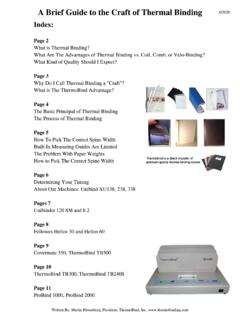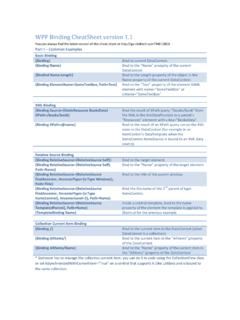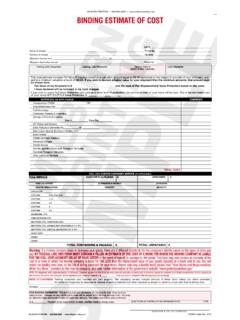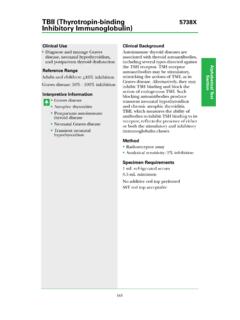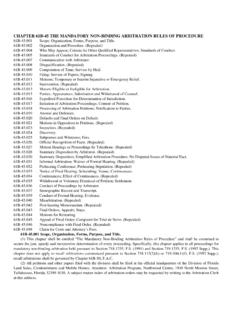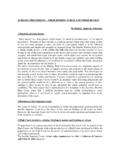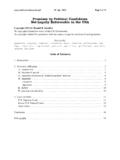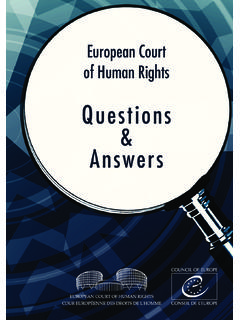Transcription of TG-1601 is a novel BET inhibitor with strong binding ...
1 5790. < strong >TG-1601strong > is a < strong >novelstrong > BET < strong >inhibitorstrong > with strong < strong >bindingstrong > affinity and long-lasting effect in preclinical models Emmanuel Normant1, Leonid Gorelik2, Rama Shmeis1, Henry Le1, Robert Nisch1, Karen TenHuisen1, Teja Turpuseema1, James Oliviero2, Dhanalakshmi Sivanandhan3, Payal Kiran Parikh3, Hari P. Miskin1, Peter Sportelli1 and Michael S. Weiss1. 1) TG Therapeutics, New York, NY; 2) Checkpoint Therapeutics, New York, NY, 3) Jubilant Biosys, Bangalore, India Background In vitro and in vivo Pharmacodynamic activity In vivo anti-tumor activity Pharmacodynamic markers BET (bromodomain and extra-terminal) proteins bind to acetylated Kd (nM) In vitro pharmacodynamic activity of < strong >TG-1601strong > In vivo anti-tumor activity in MM1s multiple myeloma model In vivo and ex-vivo validation of CCR2 and IL1RN. lysine residues on chromatin and participate in the regulation of gene < strong >TG-1601strong > and two related BET inhibitors transcription. Inhibition of BET protein < strong >bindingstrong > to chromatin with small bromodomain < strong >TG-1601strong > JQ1 OTX-015.
2 < strong >TG-1601strong > ( M) 24h molecules selectively suppresses the transcription of a set of BRD2(BD1) 57 20 Left panel: Tumor volume;. The black solid bar on the X. oncogenes, including MYC and BCL-2. BRD2(BD2) 35 3 axis indicated the period of treatment. Right panel: Body BRD3(BD1) 4 32 12. < strong >TG-1601strong > (aka CK-103) is a < strong >novelstrong > , selective and potent small molecule BRD3(BD2) 38 2. weight changes compare to pre-dose weight. < strong >inhibitorstrong > of BET bromodomains. < strong >TG-1601strong > binds to the first and second BRD4(BD1) 11 31 13 The blue rectangles represent bromodomains (BD1, BD2) of the BET protein family, BRD2, BRD3, BRD4(BD2) 29 the interruption of dosing from Day 18 to Day 25 to BRD4, and BRDT, with Kd values ranging from nM to nM. MYC BRDT(BD1) 120 28 allow body weight to recover. < strong >TG-1601strong > ( M). protein expression is strongly inhibited in the MV4-11 cancer cell line BRDT(BD2) 51 10. with an EC50 of 5 nM, with GI50 comprised between 15 nM and 85 nM CREEBBP 640 > 3000 > 3000. in a variety of leukemia and myeloma cancer cell lines, indicating EP300 660 > 3000 > 3000.
3 Potent inhibition of cell proliferation. < strong >bindingstrong > constants were assessed using the BROMO scan platform from Methods: SCID/Beige mice were inoculated subcutaneously with MM1s cancer cells to establish the tumor model. The < strong >TG-1601strong > dose Discoverx. The assay includes trace bromodomain concentrations (< administered was 10 mg/kg, bid. Time course and dose-response studies conducted in mice bearing nM) and thereby report true thermodynamic < strong >inhibitorstrong > Kd values. Left panel: < strong >TG-1601strong > was spiked in whole blood at increasing concentrations (n=4). The control samples were spiked with Results: < strong >TG-1601strong > (10 mg/kg, bid) reduced tumor volume by 70% at day 28, 17 days after the start of treatment (left panel). After the DMSO, final. RQ: ratio of target gene / GADPH. subcutaneous MV4-11 xenografts showed that MYC protein was first week of treatment, average body weight was reduced by 5%. Treatment was interrupted for 1 week and then resumed. During this Right panel: In an in vivo experiment, < strong >TG-1601strong > 3, 10, 30 mg/kg was orally administered to MV4-11 tumor-bearing mice, and intra-tumoral MYC and IL1RN mRNA quantified by qPCR (n=3).
4 Undetectable 3 hours following a single 25 mg/kg oral dose, with a TG- drug holiday period (blue rectangles), tumors in the treated arm did not grow back as fast as in the vehicle arm, suggesting that this Selectivity tree of < strong >TG-1601strong > therapeutic window did not impact efficacy. During drug holiday, mice recovered and body weight of the treated group was similar to 1601 tumor concentration of 5 M achieved. Interestingly, at 24h post- (1 M) on 32 bromodomain- the vehicle treated group. Methods: < strong >TG-1601strong > ( , , 1 and 10 M) was spiked in whole blood of 4 healthy volunteers and the RNA. dose, while < strong >TG-1601strong > is cleared from the tumor, MYC protein level containing family members Later solution was added 3 hrs after dosing to stabilize mRNA. CCR2 and IL1RN mRNA were quantified using Conclusion: < strong >TG-1601strong > demonstrate activity in a multiple myeloma xenograft model. A therapeutic window of one week did not impact qPCR. remains below 40% of its initial level, indicating a long-lasting effect Using the assay presented above, the the efficacy of the treatment.
5 < strong >TG-1601strong > ( M). pharmacodynamic of < strong >TG-1601strong > , potentially attributable to enhanced displacement of the bromo-probe by < strong >TG-1601strong > ( M) Results: IL1RN and CCR2 mRNA expressions are both under BET control, and have been shown to be < strong >bindingstrong > affinity compared to earlier generation molecules. 1uM < strong >TG-1601strong > was assessed on 32. bromodomain containing proteins. In vivo anti-tumor activity in MV4-11 AML model decreased under BET < strong >inhibitorstrong > treatment. CCR2 was decreased by 50%, 40% and 30% and IL1RN by 72%, 63%, Methods: MV4-11 cells were seeded in 96 wells and incubated with increasing concentrations of < strong >TG-1601strong > for 6 or 24 hrs. mRNA or protein were extracted from and 35% when < strong >TG-1601strong > was spiked at 10 nM, 100 nM, 1 M and 10 M respectively (left panel). In another cell lysate, and qPCR or Western blot were run. GADPH was used as a loading control. Methods: < strong >TG-1601strong > was dosed 20 mg/kg/day, either experiment, in the MV4-11 xenograft model, < strong >TG-1601strong > -induced inhibition of the intratumor level of IL1RN and In agreement with this long-lasting effect, efficacy studies in MV4-11 On the phylogenic tree (TreeSpot).
6 Presented here, < strong >TG-1601strong > only binds continuously or using a schedule that included 2, 3 MYC were very comparable (Figure 4, right panel). tumor-bearing mice, dosed with a 20 mg/kg/day PO regimen the members of the BET family. Results: Consistent with published data, the BET < strong >inhibitorstrong > < strong >TG-1601strong > induced the rapid down-regulation of MYC and BCL2 mRNA in the MV4-11 AML cell line and 4 days off per week. < strong >TG-1601strong > was also dosed (more than 60% inhibition compare to control, (Figure A and B) at doses that induced cell growth inhibition. At 24 hrs, MYC protein expression was strongly 20 mg per day, using a 10 mg/kg bid schedule. Conclusions: IL1RN and CCR2 mRNA detection directly in the blood of patients treated with < strong >TG-1601strong > can serve interrupted by increasing drug holiday periods, showed that drug The diameter of each red sphere is inhibited (EC50 = 5 nM, Figure C). In addition, the tumor suppressor gene p21, a well-known MYC target, was upregulated upon MYC suppression by < strong >TG-1601strong > as a surrogate pharmacodynamic marker during the dose-escalation Phase 1 clinical trial.)
7 These two genes inversely proportional to Results: TGI% were 94%, 91%, 78% and 82% in holidays of 2, 3 and 4 days per week only modestly affected efficacy The < strong >bindingstrong > of the bromo-probe (that (Figure D) by , and when cells were treated with < strong >TG-1601strong > at , and 1 M, respectively. groups treated with 20 mg/kg continuously with no have been used in clinic to assess BET < strong >inhibitorstrong > target engagement. Here we show that < strong >TG-1601strong > blocked both mRNA expression in a dose-dependent manner, and MYC and IL1RN imRNA expression are similarly inhibited (3%, 15% and 12% TGI respectively), suggesting discontinuous dosing of has not been displaced by < strong >TG-1601strong > ). Conclusions: Consistent with published data, the BET < strong >inhibitorstrong > < strong >TG-1601strong > induced in cells the rapid down-regulation of MYC and BCL2 and an increase of p21 drug holiday, or with 2, 3 and 4 days off per week, by < strong >TG-1601strong > in vivo. respectively. < strong >TG-1601strong > in clinic may not significantly impact efficacy. mRNA. In vivo pharmacodynamic activity of < strong >TG-1601strong > Results suggest that drug holidays can be applied without losing efficacy.
8 In addition, the 10 mg/kg Conclusions twice a day schedule was more efficient than the Methods: In both studies, athymic nude mice were inoculated 20 mg/kg once a day, as 6/6 mice were tumor free subcutaneously with MV4-11 cancer cells to establish the < strong >TG-1601strong > is a < strong >novelstrong > and potent BET < strong >inhibitorstrong > that specifically inhibits the < strong >bindingstrong > In vitro cytotoxic activity tumor model. The doses administered were 3, 10 and 30 mg/kg once (lower panel) or 25 mg/kg, once (upper panel). In each at day 15 in the 10 mg/kg arm, whereas no mice were tumor free in the 20 mg/kg dosing. of the BET sub-family of bromodomain-containing protein family study, < strong >TG-1601strong > doses were administered by oral gavage. C-Myc Efficacy (TGI%) were correlated in all arms with a < strong >TG-1601strong > potently inhibits cell growth of various multiple myeloma and protein expression was monitored using Western blotting and decrease of MYC mRNA level of 60% or more (data GADPH was used as a loading control. < strong >TG-1601strong > levels were not shown).
9 Lymphoma cell lines in vitro, but does not affect the growth of normal assessed in plasma and tumor (lower panel) or tumors (upper (transformed) cell lines. panel). Conclusion: Orally administered < strong >TG-1601strong > . demonstrated significant anti-tumor activity at < strong >TG-1601strong > inhibits MYC expression: 20 mg/kg/day. Insertion of drug holidays did not significantly affected the efficacy of < strong >TG-1601strong > , In vitro, < strong >TG-1601strong > potently inhibit Myc expression at the RNA and protein suggesting that treatment interruptions during Results: In the first experiment (lower panel), c-Myc protein clinical trial could be beneficiary by increasing the levels MV4-11 tumor-bearing mice were dosed with 25 mg/kg < strong >TG-1601strong > once and tumor removed at levels were decreased by 57%, 77% and 72% 3 hrs after 3, 10 therapeutic window. 1 h, 3 hrs, 6 hrs and 24 hrs post-dose. Western blots run on tumor lysates, and immunoblot and 30 mg/kg < strong >TG-1601strong > oral gavage, respectively. At these doses In vivo, < strong >TG-1601strong > totally inhibits Myc protein expression at 3h post dose.
10 Scanned and quantified. < strong >TG-1601strong > was quantified in tumor lysate for each time point (n=3). < strong >TG-1601strong > tumor concentration was 465, 915 and 5502 ng/mL Interestingly the level of c-Myc did not come back to its original levels at respectively. At these doses, CCR2 mRNA levels were decreased by , and respectively (data not shown). In vivo anti-tumor activity in combination with anti-PD-1 antibody (B16 syngeneic model) 24 hrs, even though < strong >TG-1601strong > was barely detectable in the tumor. This may suggest a long-lasting effect of the drug in this model. In a second experiment (upper panel), c-Myc protein levels < strong >TG-1601strong > concentration (ng/ml or ng/g). were decreased by 38%, 99%, 72% and 65% 1 h, 3 hrs, 6 hrs and 5000. 24 hrs after a single 25 mg/kg < strong >TG-1601strong > dose, respectively. At Methods: BALB/c immunocompetent mice were In different in vivo xenograft models, < strong >TG-1601strong > potently inhibits tumor growth vehicle these times < strong >TG-1601strong > tumor concentrations were 2315, 2646, inoculated subcutaneously with the mouse B16F10 and drug holidays do not alter its anti-tumor activity that treatment 4000 anti-PD-1.
